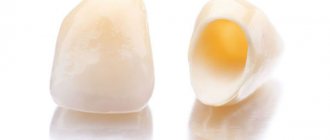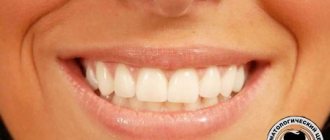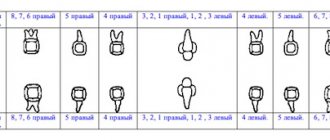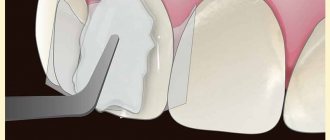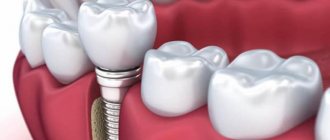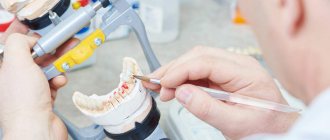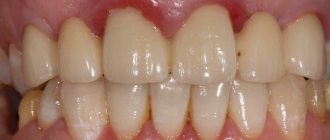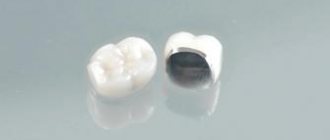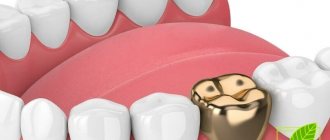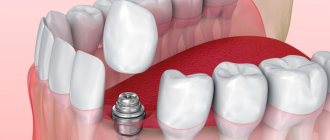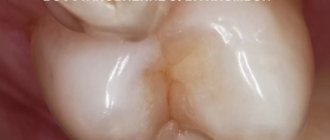Indications for the installation of porcelain crowns
The main indication for the installation of porcelain crowns is the aesthetic restoration of the front teeth:
· wedge-shaped defects and chips that cannot be eliminated using filling material;
Complete destruction of the dental crown;
· enamel hypoplasia;
Abnormalities in tooth color or shape;
· a pronounced change in the shade of tooth enamel that cannot be corrected using professional hygiene methods.
In addition, such designs are suitable for patients who are allergic to metal.
Stages of manufacturing and installation of porcelain crowns
First of all, at the appointment, the dentist examines the patient’s oral cavity, identifies possible contraindications, and, if necessary, carries out a complete sanitation. Only after this can you proceed to the next stage - preparing the tooth for a porcelain crown and selecting the optimal shade for the future design using a special template.
Next, the doctor takes a combined impression of the tooth and the entire dentition. And if the quality of the casts is satisfactory, it is sent to a dental laboratory, where a plaster model is made based on them.
Direct production of a porcelain crown can be carried out in two ways. The first involves layer-by-layer application of porcelain substance, and the second uses injection molding technology. It is the second option that is more modern and gives the structure high strength,
Therefore, it is used in most dental laboratories.
After the impression falls into the hands of a specialist, he uses thin platinum foil to create a mold for the future dental crown and fills it with a porcelain composition, and then exposes it to high temperatures several times.
The final stage of making a porcelain crown is the correction of the structure, its staining and glazing.
After the crown is ready, it is first tried on. If the result suits both the doctor and the patient, it is finally fixed on the previously prepared tooth.
Orthopedics / Manuals 3rd year / autumn semester / topic 11
Lesson No. 11
Lesson topic
: Porcelain and plastic crowns. Conditions for tooth preparation. Receiving impressions.
Purpose of the lesson
: to study the indications for the manufacture of aesthetic prostheses from ceramics, the clinical and laboratory stages of their manufacture. To teach students to determine the indications for the restoration of defects in the coronal part of the tooth with plastic crowns, and to prepare the hard tissues of the tooth during their manufacture. Familiarize yourself with the laboratory stages of making a plastic crown and the polymerization process. To master the process of one-step (clinical) production of temporary plastic (provisional) crowns from rapidly polymerizing plastics.
A task to control initial knowledge, taking into account the questions necessary for this lesson and studied previously:
Situational task.
A 25-year-old patient came to the clinic for prosthetic treatment with complaints of impaired aesthetics due to discoloration and partial destruction of the front teeth in the upper jaw.
Dental formula:
7 6 5 4 3 2 1 1 2 3 4 5 6 7 8
7 6 5 4 3 2 1 1 2 3 4 5 6 7 8
The bite is straight, all teeth are stable. 11 and 21 are destroyed by 1/3 with a violation of the cutting edge, changed in color. The marginal fit of composite fillings is broken.
Task 1. What is the external inspection?
1) Determination of the height of the lower third of the face,
2) Determination of facial asymmetry,
3) Determination of the position of the anatomical formations of the face.
Task 2. What formations should be palpated in the patient?
1) TMJ joints,
2) Chewing muscles,
3) Lymph nodes.
Task 3. What paraclinical research methods should be used on the patient?
1) Targeted intraoral radiography 11, 21,
2) EDI to determine the viability of the pulp 11, 21.
Task 4. Make a diagnosis.
1) Defect of hard dental tissues, class 3 according to Black,
2) Defect of hard dental tissues, class 3 according to Black.
Task 5. Outline a plan for orthopedic treatment provided that pulps 11 and 21 are viable.
1) Prosthetize the defect of hard tissues of the urinary tract with crowns,
2) Prosthetics with porcelain crowns,
3) Prosthetics with temporary plastic crowns followed by replacement with porcelain crowns.
Task 6. Justification of your decision to depulpate 11 and 21.
1) Age of the patient,
2) The risk of traumatic pulpitis,
3) Fear of complications in the future.
Task 7. What type of anesthesia should be used when preparing teeth 11 and 21.
1) Conductor,
2) Infiltration,
3) Intraligamentary,
4) General anesthesia.
Task 8. The type of ledge required for prosthetic restoration with a porcelain crown.
1) Straight shoulder along the entire perimeter of the tooth,
2) Direct ledge on the vestibular side,
3) Mixed ledge.
Task 9. What taper is required when preparing 11 and 21 for porcelain crowns?
1) 5 – 70,
2) 8 — 150
3) Cylindrical shape.
Task 10. What type of impression should be used when making prosthetics with porcelain crowns?
1) Anatomical impression with alginate mass,
2) Functional impression,
3) Taking an impression using a ring,
4) Double print.
Task 11. Is it possible to temporarily fix porcelain crowns?
1) No,
2) Yes,
3) Possible for up to 5 – 7 days.
Standards of answers to control tasks of the initial level of knowledge:
Problem: 1) – 3; 2) – 1.2; 3) – 1.2; 4) – 2; 5) – 3; 6 )– 1.2; 7) – 2.3;  – 1; 9) – 1; 10) – 3,4; 11) – 1.
– 1; 9) – 1; 10) – 3,4; 11) – 1.
Brief summary of the topic
.
Porcelain crown -
This is a prosthesis that serves to restore the shape and function of the crown of a tooth and is made by firing dental porcelain.
Main indications
Porcelain crowns are:
1) the impossibility of restoring the destroyed crown of the frontal teeth of the upper jaw, including the first premolar, using fillings and inlays;
- significant aesthetic defects (change in tooth color, loss of shine, loss of shape);
- the presence of artificial crowns made of metal or plastic that do not meet aesthetic requirements in the frontal region;
- damage to hard dental tissues of non-carious origin (external amelogenesis, fluorosis, pathological abrasion (vertical), wedge-shaped defects);
5) some anomalies in the shape and position of the tooth. Contraindications:
- prosthetics with porcelain crowns under the age of 18;
- making crowns for the teeth of the lower jaw, especially incisors;
- periodontitis;
- low crown part of the tooth (horizontal pathological abrasion);
- deep bite, deep incisal overlap.
Tooth preparation
under a porcelain crown must guarantee the safe condition of the pulp and periodontium, and also comply with the necessary technological parameters that ensure high strength and aesthetic properties of artificial crowns. The most important condition for preparing a tooth for a porcelain crown is the creation of a circular ledge located at right angles to the axis of the tooth, of sufficient thickness, which ensures the strength of the porcelain crown.
Preparation of a tooth with living pulp is carried out under anesthesia with 2-4% anesthetics, such as infiltration or intraligamentary anesthesia. During preparation, safety zones should be taken into account (according to N.G. Abolmasov). For preparation, separation discs and shaped heads (cylindrical, conical, flame-shaped, end-face) are used. Dissection is carried out under water cooling, intermittently.
First, tissue is removed from the approximal surfaces with a separation disc, giving the tooth a slightly conical shape to the level of the tooth neck. Often, instead of a separation disc, a flame-shaped bur is used (if the preparation is made on a turbine drill). Then, using a spherical bur with a diameter of 1 mm, a groove is made along the level of the tooth neck to the depth of the bur. This allows you to form a uniform ledge around the entire circumference of the tooth. Then, using a conical diamond bur, the tissue is evenly removed from all sides. The bite separation should be 1-1.5 mm. The last stage of preparation is to immerse the ledge (1-1.5 mm wide) with an end bur under the gum to a depth of 0.2 mm. Some authors recommend putting on a temporary crown and taking an impression only after a week.
Before taking an impression, the gums are retracted using retraction rings with retraction liquid, which are inserted under the gum by the shoulder for 15 minutes. After this, an impression is taken with silicone mass, which does not shrink (like a double impression).
Then an impression is taken from the opposite jaw, and the central occlusion is determined. The tooth stump is covered with fluoride varnish. The clinical stage ends with the production of a temporary “provisional” plastic crown, which will keep the gums from forming scars and protect the tooth, if it is not pulpless, from external irritants and the penetration of infection into its cavity. At the same visit, the color of the future porcelain crown is determined.
In the laboratory, a technician casts a combined (dismountable) model. Then the stump of the tooth, prepared for the porcelain crown, is crimped with platinum foil 0.025 mm thick. It serves as a base on which a primer layer is applied and fired in a vacuum oven at a temperature of 1120°C according to the program. A second layer of primer is applied and fired. Then the dentin and transparent layers are laid and fired again in an oven at 940°C under vacuum. The manufactured crown is processed with a diamond tool and fitted to the models.
Next, the crown is sent to the clinic for fitting. The doctor carefully fits the crown into the oral cavity using carbon paper, paying attention to the shape, color of the crown, its location in relation to the antagonist teeth, and the uniformity of immersion under the gum. If the crown meets all the requirements, it is sent to the dental laboratory to apply the final layer - glaze, special dyes; if necessary, firing is carried out in a furnace at a temperature of 940°C without vacuum. The platinum cap is then removed.
In the clinic, the porcelain crown is fitted and fixed with permanent cement. When fixing, it is necessary to use materials that do not distort the color of the porcelain crown.
This type of crown, which is made of porcelain mass, but on a tooth prepared with a circular shoulder, is called a “Jacket crown.”
When using porcelain crowns for prosthetics, the following errors and complications are possible.
- Chronic inflammation of the gingival margin (trauma to the gingival margin when creating a ledge, incorrectly made temporary crown, patient’s reaction to temporary zinc-eugenol paste, sharp edge of a porcelain crown).
- Pulpitis (thermal burn, chemical burn of the pulp during the manufacture of a temporary crown made of acrylic plastic).
- Crack and fracture of part of the crown (insufficient preparation of tooth tissue when creating the interocclusal space, violation of the regime and methodology during the laboratory stages of manufacturing).
4. Crown color mismatch.
Plastic crowns
Metal crowns lack aesthetic qualities, so they are not suitable for orthopedic treatment of defects in the coronal part of individual teeth in the frontal area of the jaw. For this pathology of the dental system, plastic crowns are widely used.
contraindications exist for plastic crowns
deep bite, deep incisal overlap, pathological abrasion of teeth, allergy to plastic. The absence of lateral teeth is a relative contraindication.
To make plastic crowns, tissues are ground on all sides of the tooth to create steep (with slight convergence) walls. The separation from the antagonist teeth should be at least 1.0-1.5 mm. The tooth is prepared without a ledge (temporary crowns) and with a ledge.
Preparation begins with the separation of the proximal surfaces of the tooth crown. Then, using diamond cylindrical or cone-shaped heads, the tooth tissue is removed up to the neck. A ledge is formed in the cervical area, which should be at least 0.5-0.8 mm, and it is better to increase its width to 1 mm. Then, using an end drill, it is lowered under the gum by 0.1 mm, but no more, since the plastic swells under the influence of saliva and can cause hyperemia, swelling, and sometimes necrosis of the mucous membrane. The ledge is made at an angle of 90° to the tooth axis.
But if the cervical area is affected by caries, it is impossible to prepare a tooth with a ledge.
Plastic crowns made for a tooth with a ledge are called “jacket” (more correctly, “Jacket crowns”).
It is better to take an impression using silicone mass or using a double impression (thermoplastic mass and corrective mass). If the tooth is prepared with a shoulder, it is better to perform gum retraction (retraction cord and retraction fluid) before taking the impression. An impression is taken from the opposite jaw (as an auxiliary one). The color of the future crown is determined.
After this, 2 plaster models are cast in the laboratory. In one model, a technician uses wax to model the future plastic crown, giving it the anatomical shape of the tooth being restored. In this case, the wax must be colorless so that the dye from the wax does not transfer to the plastic. The technician then casts the model into a ditch, evaporates the wax and packs the diluted Plas or Sinma-M. The cuvette is closed and immersed in cold water, which is gradually brought to a boil over 45 minutes. Then it boils for 45-60 minutes, then the fire is turned off, and the cuvette is kept in water until it cools completely.
The technician removes the finished plastic crown from the ditch, processes it and adjusts it on the second plaster model, according to the relationship with the antagonist teeth and adjacent teeth. After this, the crown is sent to the clinic for fitting.
The doctor prepares the finished crown with carbon paper. The crown is adjusted so that it sinks only 0.1 mm under the gum. If the crown meets all the requirements, it is processed and polished, and then sent to the clinic. The doctor treats it with alcohol and air, dries the tooth and fixes it with cement of the color that can correct the resulting shade (plas - white, "Visfat-cement" - yellow, "Uniface" - slightly yellow).
There are also plastic crowns that are temporary, i.e. are placed during the production of a porcelain or metal-ceramic crown. They are also called “provisional” crowns.
If the crown of the tooth is preserved (the tooth is changed in color, filled with fillings) and either a porcelain or metal-ceramic crown will be made on it, then an impression is taken with silicone mass before preparation. Then, after preparing the tooth, diluted fast-polymerizing plastic (Stractur, Scutan Protemp, Cron-mix, etc.) is placed in the impression, and the impression is inserted into the oral cavity until the plastic hardens. The impression with the plastic crown is then placed in hot water for final polymerization. The plastic crown is removed, processed, polished and fixed to temporary material (aqueous dentin, zinc oxyeugenol masses).
Possible mistakes:
- thin fragile crown; the tooth is prepared incorrectly;
- fragile crown due to violation of the polymerization regime;
The color of the plastic is incorrectly determined.
Tasks to monitor learning results.
1.
The tooth is prepared with a ledge for a plastic crown
1) mandatory,
2) only on the vestibular surface,
- if it is depulped,
- not necessary,
- if the patient is over 25 years old.
2.
The plastic crown should be positioned in relation to the edge of the gum
- not reaching the gum by 0.3-0.5 mm,
- not reaching the gum by 1.0 mm, —
- at the level with the gum,
- under the gum by 0.2-0.3 mm.
3
. Fix the porcelain crown with temporary cement
- possible for any period of observation of the patient,
- possible, if the patient does not have bruxism,
- possible for no more than 5-7 days,
- it is forbidden.
4.
Under a porcelain crown, the final line of tooth preparation at the edge of the gum has the shape
- "ledge symbol"
- a slope-shaped ledge at an angle of about 135°,
- straight ledge At an angle of 90°,
- trough-shaped,
5) a ledge with a beveled edge.
5.
After tooth preparation, vascular disorders in the pulp can be eliminated after
- one week, 3) one month,
- two weeks, 4) one year.
6.
The ledge in the cervical part of teeth prosthetized with plastic crowns is prepared in order to
- improving crown fixation,
- preventing contact of the crown edge with gum tissue,
- creating a strong crown edge,
- preventing the dissolution of the crown-fixing cement by oral fluid,
- creating a supporting platform for the edge of the crown,
- increasing the aesthetic qualities of the crown,
- 1+2+3+4+5+6.
7.
To make a cap when modeling and firing refractory porcelain, foil is used
- golden,
- palladium,
- platinum,
- cadmium,
- titanium.
8.
The thickness of the platinum foil used in the manufacture of a porcelain crown is equal to
1)0.1 mm, - 4)0.05 mm,
2) 0.01 mm, 5) 0.075 mm,
3)0.025 mm, 6) 0.5 mm.
9.
The porcelain crown in the patient’s mouth is checked
1) after removing the gold (platinum) cap from it,
2) together with a gold (platinum) cap.
10.
Porcelain firing in the manufacture of porcelain crowns is carried out on the cap
1) palladium, 3) platinum,
2) cadmium, 4) silver.
11.
When preparing a tooth for a porcelain crown, the shoulder should be prepared
on the vestibular surface,
1) vestibular and contact surfaces,
2) vestibular, contact and oral surfaces,
3) vestibular, contact, oral and occlusal surfaces.
Standards of answers to tasks to monitor learning
- – 1; 2) – 3; 3) – 4; 4) – 3; 5) – 3; 6) – 7; 7) – 3; 8)– 3; 9) – 2; 10) – 3; 11) – 3.
Assignment for the next lesson:
Learn theoretical material on the topic: Protection of teeth after preparation from external influences (medication, provisional crowns). Clinical production of a temporary crown from self-hardening plastic.
Literature
- Oksman IM. Orthopedic dentistry. — 1978.
- Gavrilov E.I., Shcherbakov A.S. Orthopedic dentistry. — 1984.
- Abalmasov N.G., Abapmasov N.N., Bychkov V.A., Shagimurina V.R. Replacement of defects in teeth and dentition with fixed dentures. -1995
- Kurlyandsty V.Yu. Ceramic and solid-cast fixed dentures. - M: Medicine, 1978.
- Gavrshuv E.I., Oksman I.M. Orthopedic dentistry. - M.: Medicine, 1978.
- Kurlyandsty V.Yu., Kopeikin V.N. Guide to practical training in orthopedic dentistry.
- Aboshaszh N.G., Abapmasov N.N. Replacement of defects in teeth and dentition with fixed dentures. - Smolensk, 1995.
Benefits of porcelain crowns
· High aesthetics. Porcelain has almost ideal optical characteristics. It very accurately conveys the natural shade and translucency that are characteristic of natural tooth enamel.
· Hypoallergenic design and inert material. Porcelain does not have thermal conductivity, so tooth sensitivity to temperature changes is reduced. Since the crown does not contain a single gram of metal, it can be installed in patients who are allergic to it.
· Long service life. With proper care, the structure will last a very long time, approximately 10-15 years, without losing its performance characteristics.
· Resistant to staining and darkening. Porcelain crowns do not lose their shade and shine, maintaining their original appearance for a long time.
· Minimum adaptation time. The patient quickly gets used to the lightweight and comfortable design.
· Easy to care for. Crowns do not require special care. It is enough to use a high-quality toothbrush and toothpaste, and treat them with care.
What is a metal-ceramic crown?
A metal-ceramic crown is a permanent dental prosthesis that is fixed to the remaining tooth. Consists of a metal frame and layered ceramic coating. More than 500 alloys are used in dentistry; alloys based on:
- gold from 70% in alloy;
- gold and other precious metals (25-50%);
- palladium (more than 50%).
The strength of the finished product depends on the frame; if it is thin, the overall resistance to occlusal load will decrease. A thick base worsens the appearance, because... over time we will shine through the ceramics. Dental technicians adhere to the rule that the minimum thickness of the frame is 0.3-0.4 mm, the maximum depends on the tooth being replaced. The thickness of the metal-ceramic prosthesis is 1.1-2.0 mm.
These crowns are designed to cover individual teeth, as well as to secure bridges in visible areas of the dentition. They are installed as a replacement for the front and chewing teeth.
Attention: if part of the crown veneer breaks off, it will not be possible to restore the integrity of the patient’s oral cavity. She is being removed.
Metal-ceramic dental crowns are not stained by food and do not have a harmful effect on surrounding tissues. The approximate service life is 5 - 15 years, depending on the materials used and manufacturing technology. The more expensive the materials and the more elaborate the manufacturing technique, the longer the crown will last (a gold-platinum alloy as a frame increases the service life to an average of 20 years).
Metal crowns with ceramic coating
Disadvantages of porcelain crowns
· High cost of construction. It is due to the complexity of technical work, which requires very high professionalism from a specialist.
· Relative fragility of the material. Patients have to avoid eating solid foods.
· Restrictions on indications. Porcelain crowns are not placed on all teeth.
· Manufacturing of single crowns only. Porcelain is not suitable for creating and installing bridges.
Types of ledges
Before proceeding with the formation of the necessary ledge, the specialist must decide which one will be suitable in this case. There are several varieties, namely:
- a rounded ledge with a groove is the most commonly used option. Most specialists use this option for creating a ledge before installing a metal-ceramic structure. The width of such a ledge ranges from 0.7 to 1.3 mm, which will subsequently preserve the hard tissues of the tooth - enamel and dentin;
- A ledge made in the form of a knife is a good option when installing solid crowns, as well as teeth that have slopes. The width of such a ledge is narrower than rounded. It ranges from 0.4 to 0.5 mm;
- the shoulder type of ledge is the least effective, but the most aesthetic type. It reaches 2 mm in width.
Types of ledges
Various forms of cervical ledges in the manufacture of artificial crowns
Video - Tooth preparation for a crown
Varieties of porcelain designs
Dental porcelain is an excellent material that provides ample opportunities for aesthetic restoration. Several types of structures are made from it:
· Veneers. These are thin plates designed to hide minor defects in tooth enamel. They cover only the front surface of the tooth. Porcelain, composite or zirconium dioxide can be used in their manufacturing process.
· Tabs. These are microprostheses made in a dental laboratory. They help solve more serious dental problems with teeth and are used, for example, in cases of severe decay of the crown or the presence of a large carious cavity.
· Crowns. The most versatile design that allows you to achieve a “Hollywood” smile. They are installed on the front teeth during aesthetic restoration.
Making a temporary crown.
For some reason, some doctors ignore this stage, leaving the choice to make a temporary crown or not to the patient. In fact, a temporary crown must be made without fail. Especially if a living tooth is being treated for a crown. It protects the gums from injury during eating, prevents neighboring teeth from moving, and in the case of a living tooth, protects the tooth from infection by oral microflora and from various irritants - temperature, chemical, etc. There are a lot of ways to make “temporary items”, so we will not dwell on this in detail. It is important that the temporary crown obtained by any of the methods sits exactly on the ledge, is well polished along the edge, and excess temporary cement is carefully removed.
The plastic temporary crown is installed exactly on the ledge (in this case, the truth is slightly different in shade from its neighbor)... After removing the temporary crown, the gums are absolutely healthy, there is no bleeding...
Metal ceramics or porcelain: what to choose?
This question arises among patients quite often. After all, each design has its own advantages and disadvantages. Thus, metal ceramics are distinguished by their high strength and affordable price, and porcelain has excellent aesthetic characteristics. Typically, the choice between them depends on which tooth needs to be restored. Crowns made of metal-ceramics are most often installed on chewing teeth, and porcelain crowns are installed on incisors and canines. However, if a porcelain crown has a zirconia framework, it can be used to restore any tooth.
Price for porcelain crowns in Moscow
The price of a porcelain crown per tooth in Moscow dentistry largely depends on the level of the clinic where the patient is being treated. In most cases, such a design is offered in dentistry at the “business” or “premium” level, where much attention is paid to the aesthetic side of prosthetics. At the same time, the price of porcelain crowns for the front teeth is practically no different from similar designs for chewing teeth.
| Type of dental crown | Price |
| Ceramic porcelain crown | 13,000 - 17,000 rubles |
| Porcelain crown on a zirconium dioxide frame | 19,000 - 25,000 rubles |
